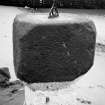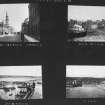Scheduled Maintenance
Please be advised that this website will undergo scheduled maintenance on the following dates: •
Tuesday 3rd December 11:00-15:00
During these times, some services may be temporarily unavailable. We apologise for any inconvenience this may cause.
Stonehaven, Old Pier, Old Tolbooth
Tolbooth (16th Century)
Site Name Stonehaven, Old Pier, Old Tolbooth
Classification Tolbooth (16th Century)
Alternative Name(s) Old Tolbooth Of Stonehaven; Stonehaven Harbour; Tollbooth
Canmore ID 36899
Site Number NO88NE 20
NGR NO 87804 85521
Datum OSGB36 - NGR
Permalink http://canmore.org.uk/site/36899
- Council Aberdeenshire
- Parish Dunnottar
- Former Region Grampian
- Former District Kincardine And Deeside
- Former County Kincardineshire
NO88NE 20.00 87804 85521
NO88NE 20.01 87815 85509 Sundial
(NO 8781 8552) Tollbooth (NR)
OS 6" map, (1928)
The Tolbooth was built as a storehouse towards the end of the 16th century. When Stonehaven became the county town about 1600 this building, being the strongest in the town, was selected as the Tolbooth. By 1897 it had reverted to its original use.
F C Eeles 1897.
The Tolbooth, as stated above, was erected by the Earl Marischal,
circa 1600. It was restored in 1963, and is now used as a tearoom.
Visited by OS (RD) 23 July 1965.
Listed.
Scottish Castle Survey 1988; N Bogdan and I B D Bryce 1991.
NO88NE 20.00 87804 85521
Stonehaven, prison.
ARCHITECT: John Smith(?)
Photographic Survey (31 October 1957)
Photographic survey by the Scottish National Buildings Record/Ministry of Work in October 1957.
Publication Account (1981)
The Tolbooth was built towards the end of the sixteenth century by the Earl Marischal and was originally used as a storehouse. When Stonehaven became the county town in 1600 this building was elected to serve as the new Tolbooth. It continued to be used for council business and as a prison until 1767 when the first part of the County Buildings was built and a new jail was erected (Watt, 1976, 41). After 1767 the upper part of the building was used as a granary while the ground floor was employed as a coal and lime store (Watt, 1976, 49). Stonehaven's Tolbooth underwent restoration in 1963 and is now a museum. In 1790 a Town House was erected at the east end of the High Street (Watt, 1976, 29).
Information from ‘Historic Stonehaven: The Archaeological Implications of Development’ (1978).
Publication Account (1996)
Situated on the old N quay of Stonehaven harbour and facing S, this gabled two-storeyed building is L-shaped on plan. It comprises a rectangular principal block, which was probably built as a storehouse in the late 16th century, and a 17th century wing, also rectangular, extending to the N. In the NE re-entrant there is a paved courtyard with an E annexe whose curved E wall abuts the SE angle of the main block.
The main block measures 18.8m from E to W by 6.5m, while the N wing, whose W side-wall is slightly out of alignment with the original W gable, measures 10.5m by 6m. A straight forestair rising against the W gable-wall of the main block provides the only access to the first floor. The walls of the tolbooth and the courtyard are constructed of local sandstone and conglomerate rubble, now very weathered. The chimneystacks, on the W gable of the main block and the N gable and W wall-head of the N block, are of ashlar and have
high bevelled copings with drip-courses. The gables are crowstepped,
with cavetto skewputts, one of which, at the W gable,
is said to have borne the arms of the Earls Marischal. 4
The openings of the main front have undergone extensive
alterations, some early slit windows being blocked and larger
chamfered ones inserted, possibly when the N block was
added. The three blocked slits at an intermediate level in the
W half of the S wall suggest that the internal floor-level has
also been altered. The doorway in the W part of this wall may
be original, but a larger loading-door has been slapped through
its E part, and a similar central opening at first-floor level has
been converted into a picture-window. While there have been
minor alterations to the windows of the N block, their present
appearance may be regarded as fairly original. A large modern
opening has been slapped though its W wall, and there is
evidence of a former opening at the centre of the E wall.
Internally there are few early features, but the ground floor of the N block retains both rubble and flagstone flooring. The ground floor of the main block contains two rooms divided towards the Wend by a stone partition-wall. At first-floor level much of the interior has been obscured by modern partitions. A curved recess in the W wall of the main block near its junction with the wing probably housed a freestanding stove. A large fireplace midway along the W wall of the rear wing, indicated by an external relieving-arch and the chimneystack above, has been blocked.
HISTORY
It is probable that the building was erected towards the end of the 16th century by the superior of the burgh, the 5th Earl Marischal, as a storehouse. It is believed to have become a tolbooth in 1600 when an Act of Parliament provided that 'the Schireff of the schiref-dome of Kincardin in all tyme to cum sail sit and hald their courtis at the Stanehyve'. In 1645 the Marquis ofMontrose, following the Earl Marischal's refusal to support him, 'syne fyris the tolbuith of Stanehevin, quhairin thair wes stoir of beir (barley) and cornis, and [the] haill toun also'. The building presumably required considerable repairs, and an account written before 1685 described 'the seat of justice for the shire, a spatious and large Tolbooth of two or three stories'. In addition to the sheriff court, it housed a prison and a meeting place for county gentlemen, and burgh business was conducted there after the Earl Marischal in 1624 authorised the election of a town council. It is probable that the ground storey of the main block was used as the prison, and through one of its windows worship was conducted by three local Episcopalian clergymen imprisoned in 1748-9 for holding illegal services. The building reverted to use for storage after the erection of the new County Buildings in 1767 (supra). It was restored in 1963 for use as a museum and, on the upper floor, a restaurant.
Information from ‘Tolbooths and Town-Houses: Civic Architecture in Scotland to 1833’ (1996).




































































